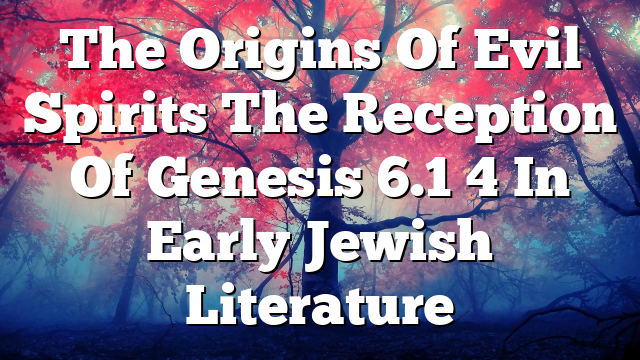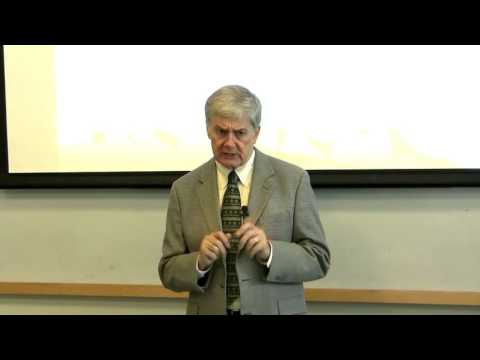Click to join the conversation with over 500,000 Pentecostal believers and scholars
Click to get our FREE MOBILE APP and stay connected
| PentecostalTheology.com



158
Book Reviews / Pneuma 29 (2007) 131-178
Archie T. Wright, The Origins of Evil Spirits: The Reception of Genesis 6.1-4 in Early Jewish Literature (Tübingen: Mohr Siebeck, 2005). xvi + 260 pp.
Archie Wright, assistant professor of biblical studies at Regent University School of Divi- nity, examines the development of the concept of evil spirits in the Second Temple Period (2TP). For him it is the reception of Genesis 6:1-4 in the third-BCE pseudepigraphic Book of Watchers ( 1 Enoch 1-36 = BW) that offers the oldest extant record of the origin of evil spirits.
The first section consists of an introduction and a chapter that surveys scholarly sources that deal with issues related to the structure, date, interpretation, and function of the Watcher tradition and some terminological clarifications. The second section (chapter 3) is a detailed discussion of Genesis 6:1-4 which includes the various biblical traditions and the interpretations of the passage by later Jewish writers. Here Wright attempts to uncover how the evil elements came to be associated with this passage by examining the key terms bene elohim, nephilim , and gibborim.
In the third section Wright deals with the following areas: reception of the Genesis text in BW (chapter 4), the rebellion motif (chapter 5), and the reception of the Watcher tradi- tion (chapter 6), particularly its “giantology” and anthropology in the Dead Sea Scrolls (DSS). He argues that the author of BW adapted and expanded the biblical tradition of bene elohim (as heavenly beings) and was influenced by two possible sources: the Shemihazah tradition (the cosmological defilement of the Watchers) and the Instruction/Asa’el tradition (the corruption of humanity through the art of war and the beautifying of women).
Wright speculates that the action of the angels was clearly rebellious. The Watchers who were never meant to cross the line of their heavenly existence mated with humans who are spirit, soul, and flesh, and created an “unauthorized new being” (153) — the giants. The spirit of the giant is a corrupted spirit that is now confined to the earthly realm, unable to approach the heavens as a spirit after its death. It is here that Wright traces the origin of evil and thus exonerates God from any responsibility for evil.
For Wright the demonology and anthropology of the Watcher tradition provides the conceptual basis for the authors of some of the DSS. The DSS contain three primary motifs that underscore the reality of the evil spirits: (1) the idea of the good and evil inclination in humanity; (2) the work of Belial and his efforts to test and tempt people to turn from God and to neglect God’s commandments; and (3) the prominence of prayers as a defense against evil spirits.
The fourth section (chapter 7) examines the treatises of Philo of Alexandria ( De Giganti- bus), in which Wright sees a clear distinction between BW and Philo’s view of giantology and anthropology. Philo’s concept of the human soul identifies two parallel dualisms at work: cosmic and ethical. He places the responsibility for evil with humanity rather than with external forces (personified as evil spirits). In the final chapter, Wright summarizes his conclusions regarding the reception of the Genesis 6 giant tradition in BW.
A few critical questions are in order. On the negative side, there a few conclusions that, although merited, may not be as strong as Wright thinks. For example Wright suggests that “the combination of the themes found in BW, DSS, and other texts, allowed for the emer- gence of a theology, demonology, and anthropology within Early Judaism that dissociated
© Koninklijke Brill NV, Leiden, 2007 DOI: 10.1163/157007407X178427
PNEU 29,1_f9_131-178.indd 158PNEU 29,1_f9_131-178.indd 158
3/30/07 8:48:26 PM3/30/07 8:48:26 PM
1
Book Reviews / Pneuma 29 (2007) 131-178
159
God from the origin of evil” (190). He thus concludes that these developing motifs eventu- ally bring about a recognized dualism in the spirit world of the first century. What Wright fails to see is that such a “disassociation” is not as monolithic as he assumes. For example, the DSS text Genesis Apocryphon (1QapGen ar20:16-30) is remarkable for its retention of the notion of an “evil spirit” sent by God to protect Abraham’s wife from Pharaoh. Simi- larly, in the Pauline writings, we see that all principalities were subservient to Christ (Col. 2:10), were originally created for him (Col. 1:16), and were disarmed at the cross (Col. 2:15, cf. Rom. 8:38-39).
Wright’s conclusions may also have some implications for the ongoing discussion of demonological beliefs and practices in Pentecostalism. Wright highlights the unresolved problem of distinct and dissimilar demonologies and their contextual developments. So, for example, Philo’s interpretation of Gen. 6:1-4 concerning the affliction of evil spirits is attributed to Platonic thought, but the author of BW is influenced by his geographical loca- tion and sociopolitical situation in that the oppression of the nation within the land of Israel led to the belief in the susceptibility of humans to attack from evil spirits. Interest- ingly, among the western classical Pentecostals, demonic issues are now of comparatively limited relevance due to the assumption that they are based on the worldview of first-century Judaism. On the other hand, the prevalence of the demonic in contemporary Africa and Asia is generally attributed to their religious and cultural contexts. If such contextual con- siderations are important, they open up possibilities for post-colonial readings of both bib- lical and Pentecostal demonologies.
Overall, this book clearly presents a strong and coherent hypothesis that attempts to make sense of the development of the problem of evil spirits in the 2TP. Wright is to be praised for bringing a highly relevant though still neglected issue before the wider theo- logical academy. He is well acquainted with scholarship on the subject, and his analysis of the reception of Genesis 6 is compelling. This book serves as a foundation for further inves- tigation of the demonology and anthropology in other early Jewish and Christian writings.
Reviewed by Finny Philip
PPNEU 29,1_f9_131-178.indd 159NEU 29,1_f9_131-178.indd 159
3/30/07 8:48:26 PM3/30/07 8:48:26 PM
2



Anonymous
The angels were created early on day one. Sometime after the Creation week there was rebellion among the angels, led by Satan.